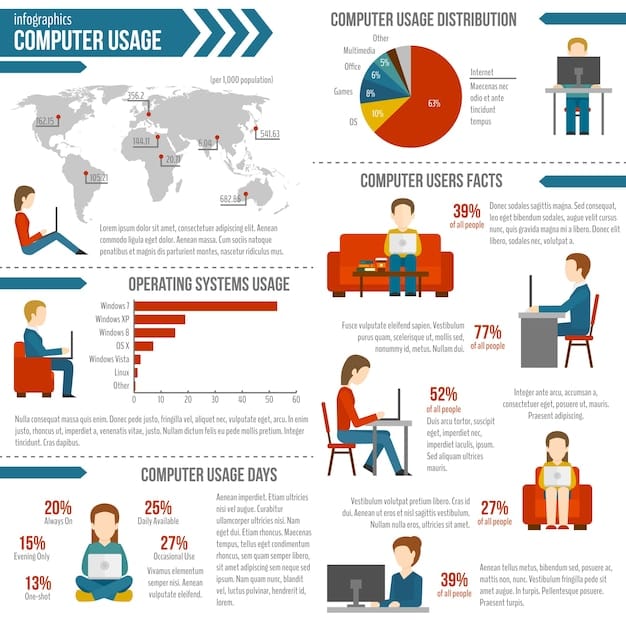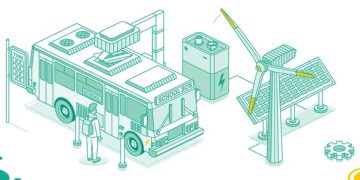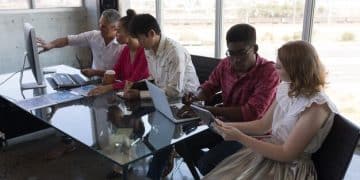The Future of Remote Work in the US: Insights for Business Leaders

Exploring the evolving landscape of remote work in the US provides crucial insights for business leaders to navigate changing dynamics, adapt strategies, and foster sustainable growth in an increasingly virtual economy.
The landscape of work in the United States has undergone a seismic shift, with remote work transforming from a niche perk into a fundamental operational model for many organizations. Understanding the Future of Remote Work in the US: Insights for Business Leaders is no longer optional; it’s a strategic imperative.
The Evolving Landscape of Remote Work in the US
The concept of working remotely, once considered revolutionary, has firmly established itself within the American business fabric. What began as a necessity during global health crises has rapidly matured into a strategic advantage, reshaping how companies attract talent, manage operations, and define their corporate culture. This evolution demands a nuanced understanding from business leaders, as the implications extend far beyond mere physical location. Remote work is now a lens through which we view productivity, employee engagement, and market competitiveness.
The transformation isn’t just about where work happens, but also how it’s structured. We’re seeing a shift from fully in-office setups to hybrid models, and for many, a continued commitment to fully remote operations. This flexibility, while offering numerous benefits, also presents unique challenges that require proactive solutions. The ability to adapt quickly and strategically is what will differentiate successful organizations in the coming years.
From Niche to Norm: How Remote Work Gained Traction
The journey of remote work from a sporadic option to a mainstream practice is a testament to its unforeseen benefits and the rapid advancements in technology. Initially, it was often tied to specific roles or industries, but recent years have shown its viability across diverse sectors.
- Technological Enablers: The proliferation of high-speed internet, cloud computing, and sophisticated collaboration tools made seamless remote operation a reality.
- Pandemic Acceleration: The global health crisis of 2020 served as an undeniable catalyst, forcing immediate adoption and demonstrating the unexpected resilience of remote models.
- Employee Demand: A growing preference for work-life balance and flexibility has made remote options a significant factor in talent attraction and retention.
The Shift from Office-Centric to Hybrid Models
The debate is no longer whether remote work will exist, but rather what its optimal form will be. Many companies are embracing hybrid approaches, seeking to combine the best aspects of in-office collaboration with the flexibility of remote work. This path requires careful planning.
This model seeks to balance individual autonomy with team cohesion, recognizing that certain activities benefit from in-person interaction while others flourish in a remote setting. Leaders must design thoughtful policies that support this blended environment, ensuring equitable experiences for all employees. It’s about designing a workplace that is intentionally flexible, rather than one that defaults to a single mode.
Strategic Advantages for US Businesses
Embracing remote work models offers American businesses a compelling array of strategic advantages that can directly impact their bottom line and long-term sustainability. These benefits extend beyond simple cost savings, touching upon critical areas like talent acquisition, operational efficiency, and market reach. For leaders, understanding and leveraging these advantages is key to unlocking new avenues for growth and competitive differentiation.
The ability to operate outside traditional geographical constraints opens up a world of possibilities, fundamentally altering how companies approach their workforce. This flexibility isn’t just a perk; it’s becoming a foundational element of modern business strategy. Organizations that master these advantages will be better positioned to navigate future economic shifts and capitalize on emerging opportunities. This strategic agility is paramount in today’s fast-paced environment.
Expanded Talent Pool and Reduced Geographic Constraints
One of the most significant benefits of remote work is the dissolution of geographical boundaries in talent acquisition. Businesses are no longer limited to hiring from their immediate vicinity.
- Access to Diverse Skills: Companies can tap into a wider pool of specialized skills and diverse perspectives, regardless of location.
- Improved Diversity and Inclusion: Remote hiring can naturally lead to a more diverse workforce, encompassing individuals from various regions, backgrounds, and life situations.
- Reduced Relocation Costs: Eliminating the need for employee relocation significantly cuts down recruitment expenses and time-to-hire.
This expanded reach not only enhances the quality of hires but also positions companies to better reflect the diverse markets they serve. It builds a more resilient and representative workforce, capable of adapting to varied consumer needs and global trends. This geographic flexibility fosters a true meritocracy.
Cost Efficiencies and Operational Flexibility
Beyond talent, remote work also offers substantial financial and operational benefits. The ability to reduce or reconfigure physical office space can lead to considerable savings.
This financial wiggle room allows businesses to reallocate resources towards innovation, employee development, or market expansion. Furthermore, the inherent flexibility of remote operations can lead to enhanced resilience during disruptions, reducing dependency on a single physical location. This adaptability underpins long-term stability and responsiveness.

Enhanced Employee Satisfaction and Retention
Employee well-being and satisfaction are directly linked to productivity and retention. Remote work, when managed effectively, can significantly boost both.
The autonomy and flexibility offered by remote work contribute to a healthier work-life balance, reducing stress and burnout. This, in turn, translates into higher job satisfaction and a greater likelihood of employees remaining with the company long-term. Businesses that prioritize this aspect will see lower turnover rates.
Challenges and Mitigations for Remote Operations
While the advantages of remote work are compelling, its successful implementation is not without its challenges. Business leaders must acknowledge and proactively address potential pitfalls to ensure that remote operations remain productive, cohesive, and sustainable. Navigating these complexities requires thoughtful strategy and a commitment to continuous improvement. Ignoring these challenges can undermine the very benefits remote work promises.
The transition to a remote or hybrid model can expose weaknesses in communication protocols, managerial training, and technological infrastructure. Solving these issues isn’t about reverting to old ways, but rather innovating new solutions tailored for a distributed workforce. It’s about building a robust digital ecosystem that supports connection and collaboration.
Maintaining Company Culture and Employee Engagement
One of the most frequently cited concerns about remote work is its potential impact on company culture and employee connection. The spontaneous interactions of an office environment are absent.
Building a strong culture in a remote setting requires intentional effort and creative approaches. Leaders must find ways to replicate or even enhance the feeling of belonging and shared purpose through digital means. This involves fostering a sense of community.
Strategies include:
- Regular Virtual Social Events: Organizing online team lunches, coffee breaks, or informal virtual gatherings.
- Dedicated Communication Channels: Creating non-work-related chat channels for casual conversations and personal sharing.
- Recognition and Celebration: Implementing virtual recognition programs to celebrate achievements and milestones.
- Leadership Visibility: Ensuring leaders are frequently visible and accessible, fostering a sense of connection despite distance.
Ultimately, culture in a remote world is less about physical presence and more about shared values, clear communication, and consistent reinforcement of what makes a company unique.
Ensuring Productivity and Performance Management
Measuring and maintaining productivity in a remote environment requires a shift in approach from traditional oversight. Leaders must trust their teams and focus on outcomes rather than hours spent.
This shift often involves implementing clear goal-setting frameworks and providing the necessary tools for employees to track their progress independently. Regular check-ins, performance reviews focused on deliverables, and a culture of accountability are crucial. It’s not about micromanaging, but about empowering.
The importance of clear expectations cannot be overstated. When employees understand their objectives and how their work contributes to the larger organizational goals, they are better equipped to self-manage and deliver results. Technology plays a crucial role here, providing platforms for project management and performance tracking.
Cybersecurity Risks and Data Protection
The distributed nature of remote work introduces new cybersecurity vulnerabilities. Employees working from various locations on diverse networks can broaden a company’s attack surface.
Leaders must implement robust cybersecurity measures and educate their remote workforce on best practices. This layered approach is vital to safeguarding sensitive company data. Continuous vigilance and adaptation are non-negotiable.
Key mitigation strategies include:
- Strong VPN Implementation: Ensuring all remote access is routed through secure Virtual Private Networks.
- Multi-Factor Authentication (MFA): Mandating MFA for all company accounts and applications.
- Employee Training: Regular sessions on phishing awareness, safe browsing, and data handling protocols.
- Endpoint Security: Deploying advanced antivirus and anti-malware solutions on employee devices.
- Data Encryption: Encrypting sensitive data both in transit and at rest.
Investing in cybersecurity infrastructure and training is not just a cost; it’s an essential investment in business continuity and trust.
Technology and Infrastructure for the Future of Remote Work
The backbone of successful remote work models in the United States is robust technology and resilient infrastructure. As companies continue to embrace distributed teams, the reliance on digital tools and seamless connectivity intensifies. Business leaders must recognize that technological investment is not merely an expense, but a strategic enabler that empowers productivity, fosters collaboration, and ensures operational continuity. Failing to invest adequately risks hindering efficiency, introducing security vulnerabilities, and ultimately undermining the remote work model’s potential.
This goes beyond simply providing laptops; it encompasses a holistic suite of solutions that support communication, project management, data security, and employee well-being. The right technology stack can transform a series of isolated remote workers into a cohesive, high-performing team. Future-proofing your tech infrastructure is crucial.
Essential Collaboration and Communication Tools
Effective communication is paramount in a remote environment. Without the luxury of in-person interactions, businesses must rely on a suite of digital tools to keep teams connected and informed.
Choosing the right combination of tools depends on the company’s specific needs and culture, but core functionalities are universal. Ensuring these tools are integrated and easy to use is crucial for adoption. This enables smooth information flow.
Key tool categories include:
- Video Conferencing Platforms: For virtual meetings, team calls, and one-on-one discussions.
- Instant Messaging/Chat Platforms: For quick queries, informal communication, and team discussions.
- Project Management Software: To track tasks, manage workflows, and assign responsibilities transparently.
- Document Collaboration Tools: For real-time co-editing and sharing of documents, spreadsheets, and presentations.
- Knowledge Management Systems: Central repositories for company policies, FAQs, and shared information.
Implementing these tools is only half the battle; ensuring employees are proficient in their use and understand the expectations for digital etiquette is equally important.
Cloud Computing and Data Accessibility
The shift to remote work has underscored the critical importance of cloud computing. Cloud-based solutions ensure that employees can access necessary files, applications, and data securely from anywhere, at any time.
This accessibility is fundamental to maintaining business operations and enabling productivity in a distributed setting. It also provides scalability and resilience, adapting to changing business needs. Data security in the cloud is also a prime concern.
Leveraging cloud platforms enables:
- Universal Access: Employees can work from any device, anywhere, without needing to be on a local network.
- Scalability: Resources can be easily scaled up or down based on team size and project needs.
- Data Backup and Recovery: Cloud providers often offer robust backup and disaster recovery solutions, protecting against data loss.
- Enhanced Security Features: Reputable cloud providers invest heavily in sophisticated security measures, often surpassing what individual companies can maintain in-house.
Emerging Technologies: VR/AR for Collaboration
Looking ahead, emerging technologies such as Virtual Reality (VR) and Augmented Reality (AR) hold significant promise for further enhancing remote collaboration. While still nascent, these technologies could redefine virtual meetings and training.
Imagine conducting team meetings in a shared virtual space, where participants feel truly present, or providing immersive training simulations to remote employees. These advancements could bridge the gap in human connection.
While widespread adoption is still some years away, business leaders should keep an eye on these developments, as they could revolutionize remote interaction. Early exploration can provide a competitive edge in the long run.
Leadership and Management in a Remote World
Effective leadership and management are fundamentally transformed in a remote work environment. Traditional oversight models, often reliant on physical presence, become obsolete. Instead, successful leaders must cultivate new skills and adopt different approaches to inspire, guide, and evaluate their distributed teams. The future of remote work in the US hinges on leaders who can adapt their strategies to foster trust, empower autonomy, and maintain cohesive team dynamics from a distance. This shift is not just about technology; it’s about a complete re-evaluation of leadership philosophy.
The essence of leadership remains the same—to guide people towards shared goals—but the methods evolve. Leaders must become more conscious communicators, more intentional culture builders, and more adept at leveraging technology to connect. It requires a proactive rather than reactive stance to team management.
Building Trust and Empowering Autonomy
Trust is the bedrock of successful remote teams. Without the direct oversight of an office, leaders must empower employees and trust them to manage their own time and delivery.
This shift from “command and control” to “trust and empower” is crucial. When employees feel trusted and have autonomy over their work, they are more engaged and productive. Clear performance indicators help reinforce this trust.
Key strategies for building trust:
- Focus on Outcomes, Not Hours: Evaluate performance based on results and quality of work, rather than visible time spent.
- Clear Communication of Expectations: Define roles, responsibilities, and project goals meticulously.
- Regular Feedback and Recognition: Provide constructive feedback and acknowledge achievements consistently.
- Delegation with Responsibility: Empower employees with ownership of their tasks and projects.
Effective Communication Strategies for Remote Teams
Communication becomes hyper-critical in a remote setting. Misunderstandings can easily arise without face-to-face cues. Leaders must be master communicators, using multiple channels effectively.
A structured approach to communication is vital, ensuring that information flows freely and clearly throughout the organization. This reduces ambiguity and keeps everyone aligned. Regular and predictable communication fosters stability.
Effective strategies include:
- Scheduled Check-ins: Regular team and individual meetings to discuss progress, challenges, and support needs.
- Asynchronous Communication Protocols: Establishing norms for using email, chat, and project management tools for non-urgent updates.
- Transparency from Leadership: Sharing company updates, challenges, and decisions openly to maintain trust and alignment.
- Actively Listening: Creating avenues for employees to voice concerns, provide feedback, and ask questions.
Supporting Employee Well-being and Battling Isolation
The flexibility of remote work can be a double-edged sword, sometimes leading to feelings of isolation or blurring the lines between work and personal life. Leaders have a responsibility to support employee well-being.
Promoting healthy work habits, encouraging breaks, and providing resources for mental health support are crucial. A compassionate and empathetic approach to leadership is more important than ever. Companies must actively combat burnout.
This involves:
- Encouraging Work-Life Boundaries: Setting expectations around “unplugging” and avoiding after-hours communications.
- Providing Mental Health Resources: Offering access to counseling services, wellness programs, and mindfulness resources.
- Promoting Social Connection: Facilitating virtual social events and informal interactions among team members.
- Flexible Work Schedules: Allowing employees some control over their work hours to better manage personal commitments.
Future Trends and Strategic Planning
As remote work continues to evolve in the US, business leaders must gaze beyond immediate challenges and proactively anticipate future trends. Strategic planning is crucial for leveraging emerging opportunities and mitigating potential disruptions in the long term. This involves a continuous assessment of technological advancements, workforce expectations, and economic shifts that will shape the remote landscape. Leaders who embrace foresight and agility will be best positioned to thrive in this dynamic environment.
The future is not static; it’s a moving target that requires constant adaptation. Companies that remain rigid in their approach will find themselves at a disadvantage. Instead, a flexible and innovative mindset will distinguish the pioneers from the followers. This forward-looking perspective is critical.
Hybrid Models: The Dominant Future?
While fully remote models have gained ground, a prevalent consensus among experts points towards hybrid models as the likely dominant future for many US businesses. These models seek to capture the best of both worlds.
This blended approach offers flexibility while preserving opportunities for in-person collaboration, team building, and mentorship. The key lies in designing intentional hybrid strategies. This balance holds significant appeal.
Elements of successful hybrid models include:
- Clear Purpose for Office Days: Defining specific reasons for in-office presence (e.g., team building, strategic planning, client meetings).
- Equitable Remote Experiences: Ensuring remote employees have equal access to opportunities, information, and influence.
- Flexible Office Space: Designing offices as collaboration hubs rather than traditional cubicle farms.
- Technology for Seamless Transitions: Equipped meeting rooms and robust networks for fluid virtual and in-person interactions.
The Rise of the “Anywhere Workforce”
Beyond national boundaries, the concept of an “anywhere workforce” is gaining traction. This means companies can hire talent globally, not just nationally, further expanding the talent pool.
This global reach introduces complexities regarding legal compliance, taxation, and cultural integration, but the strategic advantages in talent access are immense. Leaders must prepare for navigating international employment laws. It’s about globalizing talent pools.
Continuous Learning and Adaptation
The rapid pace of change necessitates a continuous learning mindset for both employees and leadership. Skills requirements are evolving, and new technologies emerge constantly.
Businesses must invest in upskilling and reskilling programs to ensure their workforce remains relevant and productive within a remote context. This commitment to ongoing development is a competitive differentiator.
Areas for continuous learning include:
- Digital Proficiency: Enhancing skills in collaboration tools, cybersecurity best practices, and remote work technologies.
- Remote Leadership Skills: Training managers on effective remote communication, performance management, and team building.
- Adaptability and Resilience: Developing soft skills that enable employees to thrive in changing work environments.
- Data Analytics: Utilizing data to understand productivity, engagement, and operational efficiencies in remote setups.
Policy and Regulatory Considerations
As remote work becomes more entrenched, so too will the regulatory environment surrounding it. Business leaders must stay abreast of evolving labor laws, tax implications, and data privacy regulations pertinent to distributed teams across different states or even countries. Proactive compliance is essential. This often requires legal counsel.
Navigating varied state-specific regulations for remote employees residing in different locations adds another layer of complexity. Ignoring these can lead to significant legal and financial penalties.
Measuring Success in Remote and Hybrid Models
For business leaders to truly understand the impact and efficacy of their remote and hybrid work strategies, establishing clear metrics for success is paramount. It’s no longer sufficient to simply have a remote policy; rather, it’s about rigorously measuring its contribution to organizational goals, employee well-being, and overall productivity. This data-driven approach moves beyond anecdotal evidence, providing tangible insights that inform strategic adjustments and optimize performance. Without proper measurement, companies risk operating on assumptions rather than actionable intelligence.
The traditional office metrics may not directly translate, requiring a re-evaluation of what constitutes success in a distributed environment. This requires a focus on outcomes and impact, rather than just inputs.
Key Performance Indicators (KPIs) for Remote Teams
Defining relevant KPIs for remote teams differs slightly from in-office metrics. While traditional productivity metrics still apply, new emphasis is placed on engagement and operational efficiency.
These KPIs provide a holistic view of remote team performance, ensuring that flexibility doesn’t come at the expense of productivity or employee well-being. It’s about understanding the nuances of remote work.
Important KPIs include:
- Output and Deliverables: Volume and quality of completed work, project completion rates.
- Employee Engagement Scores: Regular surveys and pulse checks to gauge satisfaction, motivation, and connection.
- Retention Rates: Monitoring turnover specifically for remote vs. in-office employees.
- Communication Effectiveness: Tracking response times, meeting efficiency, and collaboration tool usage.
- Cost Savings: Quantifying reductions in real estate, utilities, and commuting expenses.
Gathering Employee Feedback and Iterating Strategies
The most valuable insights often come directly from the employees themselves. Regularly soliciting feedback is essential for understanding challenges and identifying areas for improvement in remote models.
Creating an open and psychologically safe environment for feedback ensures that leaders are aware of real-world experiences. This continuous feedback loop drives iterative improvements to remote work policies.
Methods for gathering feedback:
- Anonymous Surveys: Regular check-ins on specific aspects of remote work (e.g., tools, communication, work-life balance).
- One-on-One Discussions: Managers having dedicated conversations with team members about their remote work experience.
- Focus Groups: Small group discussions to delve deeper into specific issues or gather diverse perspectives.
- Suggestion Boxes/Platforms: Digital channels for employees to submit ideas and concerns at any time.
Long-term Vision and Adaptability
The future of remote work is not a fixed destination but a dynamic journey. Business leaders must adopt a long-term vision coupled with an ingrained culture of adaptability.
This means continuously monitoring trends, experimenting with new approaches, and being willing to pivot strategies as the landscape evolves. Stagnation is the enemy of progress in this new era of work. Planning for the long haul means being ready to change. It’s about building a resilient and future-proof organization.
| Key Aspect | Brief Description |
|---|---|
| 🌐 Expanded Talent Pool | Access to diverse talent beyond geographical limits enhances hiring and skill acquisition. |
| 💰 Cost Efficiencies | Reduced overheads from smaller office footprints and operational flexibility. |
| 🛡️ Cybersecurity Awareness | Critical importance of robust security protocols and employee training for remote setups. |
| 🤝 Trust-Based Leadership | Shifting from oversight to empowering autonomy and clear communication in management. |
Frequently Asked Questions about Remote Work
Remote work offers US businesses significant advantages, including access to a wider talent pool, reduced operational costs (e.g., office space), and increased employee satisfaction and retention. It can also enhance organizational resilience during unforeseen circumstances, allowing continuity of operations. Additionally, companies often see improved diversity and inclusion in their hiring practices.
Maintaining company culture in a remote setting requires intentional strategies. This includes organizing regular virtual social events, fostering dedicated non-work communication channels, and ensuring transparent leadership communication. Consistent recognition of achievements and promoting a sense of shared purpose through digital means are also crucial for cohesion and engagement among distributed teams.
Successful remote operations heavily rely on robust technology. Essential tools include reliable video conferencing platforms, instant messaging/chat applications, and comprehensive project management software. Cloud computing solutions for data accessibility and strong cybersecurity infrastructure (VPNs, MFA, endpoint security) are also paramount to ensure productivity, collaboration, and data protection for distributed teams.
Leaders must shift from traditional oversight to a trust-based, outcome-oriented approach. This involves empowering autonomy, setting clear expectations, and providing consistent feedback. Effective communication strategies, such as scheduled check-ins and asynchronous protocols, are vital. Prioritizing employee well-being, acknowledging the challenges of isolation, and fostering a flexible work-life balance are also key components of effective remote leadership.
Hybrid models are likely to become the dominant future for many US businesses, blending the benefits of remote work with in-person collaboration. They offer flexibility while preserving opportunities for direct interaction, team building, and mentorship. Successful hybrid strategies will require clear policies for office presence, equitable experiences for remote employees, and continuous investment in seamless communication technologies to support both environments effectively.
Conclusion
The future of remote work in the US is not merely an extension of past trends but a fundamental redefinition of how businesses operate and thrive. For business leaders, navigating this evolving landscape successfully hinges on proactive adaptation, strategic investment in technology, and a profound commitment to fostering trust and connectivity within distributed teams. By embracing flexibility, prioritizing robust cybersecurity, and evolving leadership styles, organizations can unlock unprecedented opportunities for growth, enhanced talent acquisition, and sustained competitive advantage. The journey ahead demands foresight, agility, and a continuous willingness to learn and iterate, ensuring that the benefits of remote and hybrid models are fully realized for both businesses and their people.






